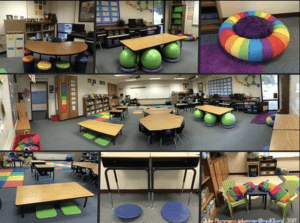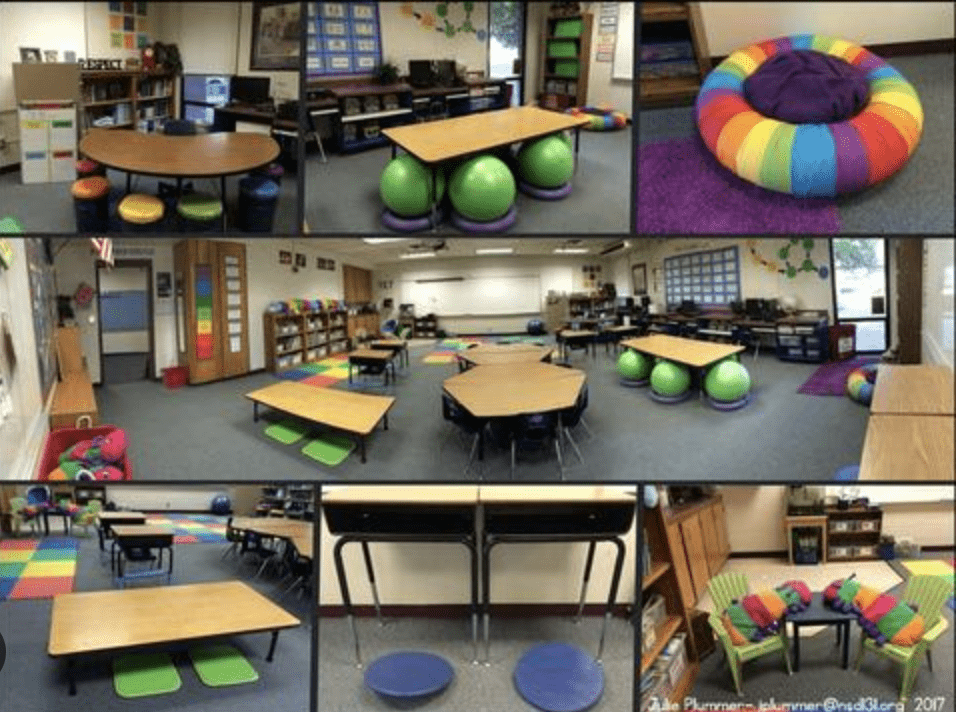Student Contributor: M. McLeod
 Flexible seating is when students have different options of where and what they can use for seating within the classroom. Flexible seating is helpful as it allows for students to be comfortable in the classroom.
Flexible seating is when students have different options of where and what they can use for seating within the classroom. Flexible seating is helpful as it allows for students to be comfortable in the classroom.
Flexible seating is used to provide several different seating options in the classroom for students. Some examples that my mentor has in her room are floor tables, stools at tall tables, wobble chairs, seat cushions. There are many more options out there as well like bean bags and scoop chairs. In my mentor’s room she has an easel right by the door that has 6 rows’, each with a card representing one of the seating options. Then there is a card with each student’s name and picture, when the student’s come into the room in the morning they move their card to the row with the card of the type of seating they would like to sit at that day. This is great for two reasons; it allows students to sit at new places and with new people each day and as a bonus it helps when taking attendance. Now rather than interrupting the student’s during their morning journaling all my mentor has to do is look at which cards haven’t been moved for the day.
I believe that the supportive phase is the best place for this tool as it is beneficial to student learning. Allowing students to choose where they sit can help them learn, by being comfortable or being able to fidget at their seat can help student’s focus and learn. I think that this tool fits best with student directed, collaborative and teacher directed theories. This is true because this tool is mainly used by the students and is to help them be successful in the classroom, it also fits under the teacher directed theory for the attendance aspect.
More Information –
Tool Source: Mentor



My mentor teacher uses this tool in her classroom. I am placed in a fourth grade, suburban classroom, with 25 students. I have seen how helpful this tool is for my students. The students in my classroom love having the choice of what kind of seat they want. They have the option of bouncy balls, pads for their chairs, or just regular chairs. The students always have the choice of switching up their seating options if they want to. Many of the students who started with bouncy balls at the beginning of the year have switched to a pad on a regular chair. The students who have chosen the bouncy balls definitely benefit from using them, because of how much they like to move in the classroom. At times these students are bouncing very hard, but it is a great way for these students to be able to move without having to get out of their chair. These seat options help students focus and learn, while fidget in their seats. Overall, this tool really supports students who might need a change of seating, or a seat that allows them to move around. I would really like to incorporate this tool into my classroom to support students who need it.
I used this tool with my 25 kindergarteners in a rural school. As we were waiting for other students in the hallways, it was getting very noisy as they were waiting for their classmates. I used this opportunity to say to students, “If you can hear me, touch your head,” and I demonstrated touching my head. Immediately, voices went off, students knew what to do, and most of the students gave me their attention. The students who did not have their hands on their heads were nudged by the person sitting next to them to put their hands on their heads. Having the students’ attention directed toward me gave me the opportunity to remind them that when we are in the hallway, our voice level should be at zero. How I can make this management tool more successful is by using the same movements I asked my students to do if they could hear me and by initially using a quiet voice and gradually increasing my voice level to volume two.
I am currently in two 5th grade classrooms where there are 48 students between the two, located in a rural community. I tested using the tool of flexible seating in one of the classrooms. One of the two classrooms already used flexible seating as a supportive tool to help student learning. This included students being able to choose between bounce chairs, rocking chairs, bounce bands, floor desks, and seat pads. I tested this tool in the classroom that did not have flexible seating because I noticed students leaning in chairs and constant inability to sit still in normal chairs. This tool was easy to prepare for, teach, and use mainly because the other classroom already used flexible seating. Because students switch classrooms for different subjects all students had experience with using flexible seating. All I needed to do was implement this tool in the classroom that didn’t offer it. I think that implementing this tool into the classroom that didn’t already have flexible seating was a success because students didn’t lean in chairs anymore which isn’t very safe. It also prevented some students from fidgeting with items in their desks because it offered them a way to bounce proactively and listen. Because students already had the experience with flexible seating students understood the roles and rules that come with this privilege. Testing and implementing this tool would probably be harder for most if you don’t already have access to flexible seating free to use at your disposal.